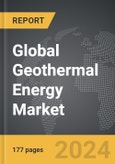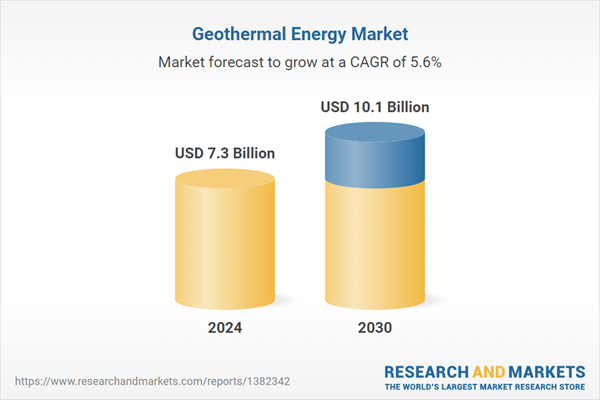The global market for Geothermal Energy was valued at US$7.3 Billion in 2024 and is projected to reach US$10.1 Billion by 2030, growing at a CAGR of 5.6% from 2024 to 2030. This comprehensive report provides an in-depth analysis of market trends, drivers, and forecasts, helping you make informed business decisions. The report includes the most recent global tariff developments and how they impact the Geothermal Energy market.
Technological advancements have significantly enhanced the efficiency and feasibility of geothermal energy projects. Enhanced Geothermal Systems (EGS), for instance, involve creating artificial reservoirs by injecting water into hot rock formations, thereby expanding the potential for geothermal energy in areas lacking natural reservoirs. Innovations in drilling technologies, such as directional drilling and improved well-casing materials, have reduced costs and increased the depth and precision of geothermal wells. These advancements have made it possible to tap into deeper and hotter geothermal resources, improving the overall efficiency of geothermal energy extraction. Furthermore, binary cycle power plants, which use organic Rankine cycle systems with organic fluids that have lower boiling points than water, have enabled the exploitation of moderate-temperature geothermal resources, further expanding the range of viable geothermal sites. Improvements in resource assessment techniques, including remote sensing, seismic surveys, and geophysical imaging, have enhanced the identification and evaluation of geothermal resources, making it easier to locate and develop new geothermal projects.
The growth in the geothermal energy market is driven by several factors, including increasing demand for renewable energy, government incentives and policies, and continuous advancements in geothermal technology. As global awareness of climate change and the need for sustainable energy sources intensifies, there is a rising demand for low-carbon and renewable energy, positioning geothermal energy as a crucial component of the renewable energy mix. Government policies and incentives, such as tax credits, grants, feed-in tariffs, and renewable energy mandates, are encouraging investment and development in geothermal projects. These incentives reduce the financial risks associated with geothermal development, making it more attractive to investors and developers. The scalability and reliability of geothermal energy make it an attractive option for both grid-connected and off-grid applications, particularly in regions with high geothermal potential such as the Pacific Ring of Fire, the East African Rift Valley, and parts of the western United States. Technological advancements are making geothermal energy more cost-competitive with traditional fossil fuels and other renewable energy sources. The integration of geothermal energy into district heating systems, where it provides heating for residential and commercial buildings, and its potential for direct use applications in agriculture, aquaculture, and industrial processes, are also expanding its market reach. For example, geothermal energy can be used to heat greenhouses, fish farms, and industrial processes, providing a reliable and sustainable source of heat. Overall, the geothermal energy market is poised for significant growth, driven by a combination of environmental imperatives, supportive policies, and technological progress, highlighting its potential to play a key role in the global transition to sustainable energy.
Segments: Power Station Type (Binary Cycle Power Stations, Flash Steam Power Stations, Dry Steam Power Stations); End-Use (Industrial, Residential, Commercial, Other End-Uses).
Geographic Regions/Countries: World; United States; Canada; Japan; China; Europe (France; Germany; Italy; United Kingdom; and Rest of Europe); Asia-Pacific; Rest of World.
The analysts continuously track trade developments worldwide, drawing insights from leading global economists and over 200 industry and policy institutions, including think tanks, trade organizations, and national economic advisory bodies. This intelligence is integrated into forecasting models to provide timely, data-driven analysis of emerging risks and opportunities.
Geothermal Energy - Key Trends and Drivers
Geothermal energy is a renewable energy source that harnesses the Earth's internal heat to generate electricity and provide heating and cooling solutions. This energy originates from the natural radioactive decay of minerals and the residual heat from the Earth's formation, which is stored in rocks and fluids within the Earth's crust. Geothermal power plants operate by drilling wells into geothermal reservoirs to access steam and hot water, which are then used to drive turbines connected to electricity generators. These plants are categorized into three main types: dry steam, flash steam, and binary cycle. Dry steam plants directly use steam from geothermal reservoirs to turn turbines, while flash steam plants pull high-pressure hot water into lower-pressure tanks to produce steam. Binary cycle plants, which use organic fluids with lower boiling points than water, allow for the exploitation of lower temperature geothermal resources, significantly broadening the geographical scope of geothermal energy projects. The constant supply of heat from the Earth ensures that geothermal energy is highly reliable and sustainable, providing a stable source of power regardless of weather conditions, unlike solar and wind energy.Technological advancements have significantly enhanced the efficiency and feasibility of geothermal energy projects. Enhanced Geothermal Systems (EGS), for instance, involve creating artificial reservoirs by injecting water into hot rock formations, thereby expanding the potential for geothermal energy in areas lacking natural reservoirs. Innovations in drilling technologies, such as directional drilling and improved well-casing materials, have reduced costs and increased the depth and precision of geothermal wells. These advancements have made it possible to tap into deeper and hotter geothermal resources, improving the overall efficiency of geothermal energy extraction. Furthermore, binary cycle power plants, which use organic Rankine cycle systems with organic fluids that have lower boiling points than water, have enabled the exploitation of moderate-temperature geothermal resources, further expanding the range of viable geothermal sites. Improvements in resource assessment techniques, including remote sensing, seismic surveys, and geophysical imaging, have enhanced the identification and evaluation of geothermal resources, making it easier to locate and develop new geothermal projects.
The growth in the geothermal energy market is driven by several factors, including increasing demand for renewable energy, government incentives and policies, and continuous advancements in geothermal technology. As global awareness of climate change and the need for sustainable energy sources intensifies, there is a rising demand for low-carbon and renewable energy, positioning geothermal energy as a crucial component of the renewable energy mix. Government policies and incentives, such as tax credits, grants, feed-in tariffs, and renewable energy mandates, are encouraging investment and development in geothermal projects. These incentives reduce the financial risks associated with geothermal development, making it more attractive to investors and developers. The scalability and reliability of geothermal energy make it an attractive option for both grid-connected and off-grid applications, particularly in regions with high geothermal potential such as the Pacific Ring of Fire, the East African Rift Valley, and parts of the western United States. Technological advancements are making geothermal energy more cost-competitive with traditional fossil fuels and other renewable energy sources. The integration of geothermal energy into district heating systems, where it provides heating for residential and commercial buildings, and its potential for direct use applications in agriculture, aquaculture, and industrial processes, are also expanding its market reach. For example, geothermal energy can be used to heat greenhouses, fish farms, and industrial processes, providing a reliable and sustainable source of heat. Overall, the geothermal energy market is poised for significant growth, driven by a combination of environmental imperatives, supportive policies, and technological progress, highlighting its potential to play a key role in the global transition to sustainable energy.
Report Scope
The report analyzes the Geothermal Energy market, presented in terms of units. The analysis covers the key segments and geographic regions outlined below.Segments: Power Station Type (Binary Cycle Power Stations, Flash Steam Power Stations, Dry Steam Power Stations); End-Use (Industrial, Residential, Commercial, Other End-Uses).
Geographic Regions/Countries: World; United States; Canada; Japan; China; Europe (France; Germany; Italy; United Kingdom; and Rest of Europe); Asia-Pacific; Rest of World.
Key Insights:
- Market Growth: Understand the significant growth trajectory of the Binary Cycle Power Stations segment, which is expected to reach US$5.0 Billion by 2030 with a CAGR of a 5.4%. The Flash Steam Power Stations segment is also set to grow at 6.2% CAGR over the analysis period.
- Regional Analysis: Gain insights into the U.S. market, valued at $2.0 Billion in 2024, and China, forecasted to grow at an impressive 5.3% CAGR to reach $1.6 Billion by 2030. Discover growth trends in other key regions, including Japan, Canada, Germany, and the Asia-Pacific.
Why You Should Buy This Report:
- Detailed Market Analysis: Access a thorough analysis of the Global Geothermal Energy Market, covering all major geographic regions and market segments.
- Competitive Insights: Get an overview of the competitive landscape, including the market presence of major players across different geographies.
- Future Trends and Drivers: Understand the key trends and drivers shaping the future of the Global Geothermal Energy Market.
- Actionable Insights: Benefit from actionable insights that can help you identify new revenue opportunities and make strategic business decisions.
Key Questions Answered:
- How is the Global Geothermal Energy Market expected to evolve by 2030?
- What are the main drivers and restraints affecting the market?
- Which market segments will grow the most over the forecast period?
- How will market shares for different regions and segments change by 2030?
- Who are the leading players in the market, and what are their prospects?
Report Features:
- Comprehensive Market Data: Independent analysis of annual sales and market forecasts in US$ Million from 2024 to 2030.
- In-Depth Regional Analysis: Detailed insights into key markets, including the U.S., China, Japan, Canada, Europe, Asia-Pacific, Latin America, Middle East, and Africa.
- Company Profiles: Coverage of players such as Aboitiz Power Corporation, Berkshire Hathaway Energy, Chevron Corporation, Enel Green Power North America, Inc., Energy Development Corporation and more.
- Complimentary Updates: Receive free report updates for one year to keep you informed of the latest market developments.
Some of the 38 companies featured in this Geothermal Energy market report include:
- Aboitiz Power Corporation
- Berkshire Hathaway Energy
- Chevron Corporation
- Enel Green Power North America, Inc.
- Energy Development Corporation
- Hyundai Motor Company
- Mitsubishi Heavy Industries Ltd.
- PT. Pertamina Geothermal Energy
- Toshiba International Corporation (TIC)
Tariff Impact Analysis: Key Insights for 2025
Global tariff negotiations across 180+ countries are reshaping supply chains, costs, and competitiveness. This report reflects the latest developments as of April 2025 and incorporates forward-looking insights into the market outlook.The analysts continuously track trade developments worldwide, drawing insights from leading global economists and over 200 industry and policy institutions, including think tanks, trade organizations, and national economic advisory bodies. This intelligence is integrated into forecasting models to provide timely, data-driven analysis of emerging risks and opportunities.
What’s Included in This Edition:
- Tariff-adjusted market forecasts by region and segment
- Analysis of cost and supply chain implications by sourcing and trade exposure
- Strategic insights into geographic shifts
Buyers receive a free July 2025 update with:
- Finalized tariff impacts and new trade agreement effects
- Updated projections reflecting global sourcing and cost shifts
- Expanded country-specific coverage across the industry
Table of Contents
I. METHODOLOGYII. EXECUTIVE SUMMARY2. FOCUS ON SELECT PLAYERSIII. MARKET ANALYSISIV. COMPETITION
1. MARKET OVERVIEW
3. MARKET TRENDS & DRIVERS
4. GLOBAL MARKET PERSPECTIVE
UNITED STATES
CANADA
JAPAN
CHINA
EUROPE
FRANCE
GERMANY
ITALY
UNITED KINGDOM
REST OF EUROPE
ASIA-PACIFIC
REST OF WORLD
Companies Mentioned (Partial List)
A selection of companies mentioned in this report includes, but is not limited to:
- Aboitiz Power Corporation
- Berkshire Hathaway Energy
- Chevron Corporation
- Enel Green Power North America, Inc.
- Energy Development Corporation
- Hyundai Motor Company
- Mitsubishi Heavy Industries Ltd.
- PT. Pertamina Geothermal Energy
- Toshiba International Corporation (TIC)
Table Information
| Report Attribute | Details |
|---|---|
| No. of Pages | 177 |
| Published | April 2025 |
| Forecast Period | 2024 - 2030 |
| Estimated Market Value ( USD | $ 7.3 Billion |
| Forecasted Market Value ( USD | $ 10.1 Billion |
| Compound Annual Growth Rate | 5.6% |
| Regions Covered | Global |









